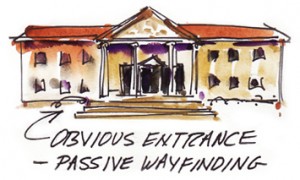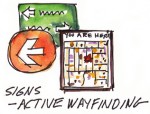 Two kinds of wayfinding tools help us get oriented and find our way around. Passive wayfinding elements are the environment itself and the built-in cues that provide intuitive information: self-evident entrances, logical pathways and predictable destination locations. Many environments and places have strong passive wayfinding and, therefore, need few directional signs. We like to work with architects and planners to help build-in passive wayfinding before the building or space is finalized.
Two kinds of wayfinding tools help us get oriented and find our way around. Passive wayfinding elements are the environment itself and the built-in cues that provide intuitive information: self-evident entrances, logical pathways and predictable destination locations. Many environments and places have strong passive wayfinding and, therefore, need few directional signs. We like to work with architects and planners to help build-in passive wayfinding before the building or space is finalized.
 Active wayfinding tools are the elements we add to an environment to facilitate orientation and successful wayfinding to supplement the passive environment – map directories, directional signs and color-coding systems. This planning and design of active tools is the primary job of the wayfinding designer. Together, active and passive elements work together to make places understandable and accessible.
Active wayfinding tools are the elements we add to an environment to facilitate orientation and successful wayfinding to supplement the passive environment – map directories, directional signs and color-coding systems. This planning and design of active tools is the primary job of the wayfinding designer. Together, active and passive elements work together to make places understandable and accessible.

